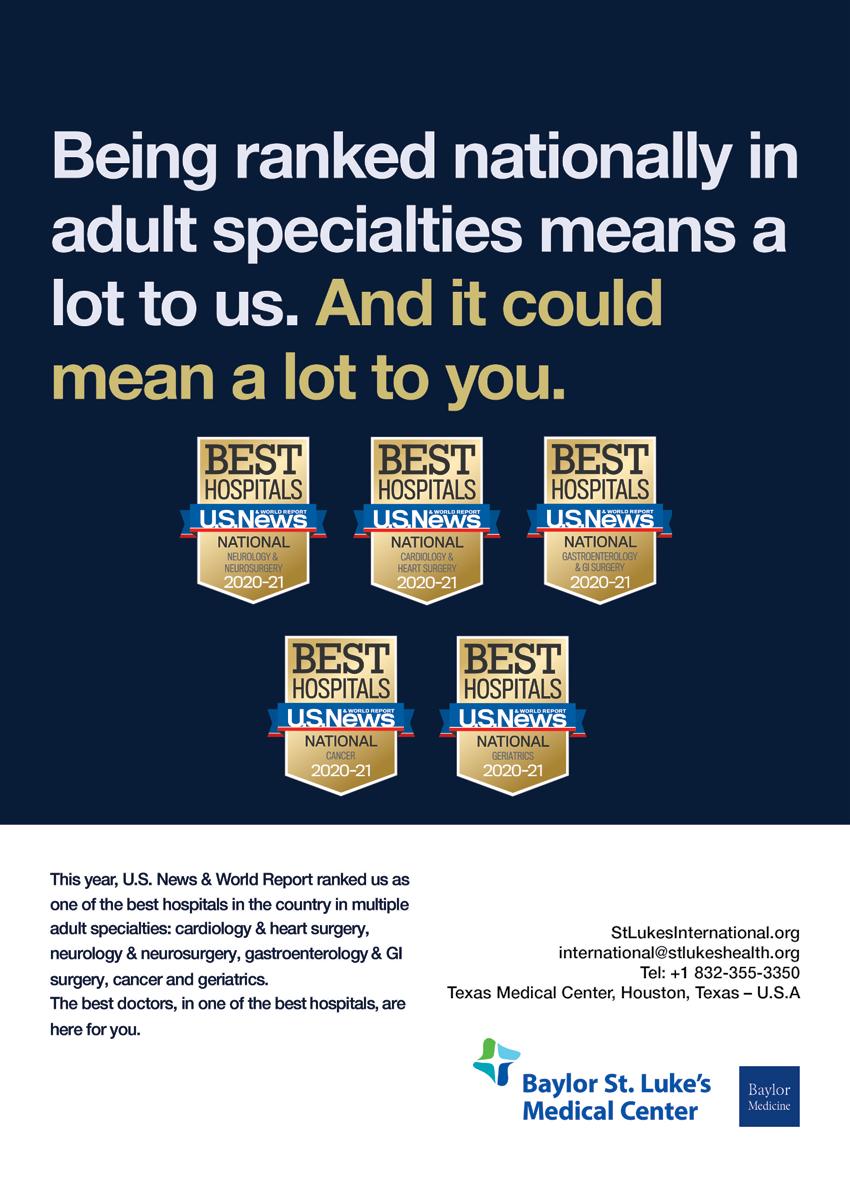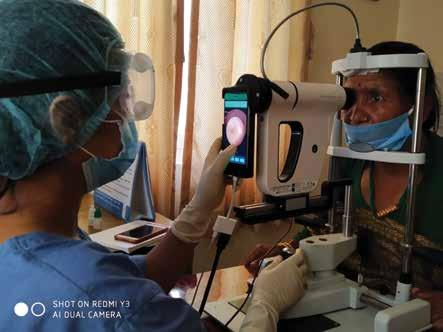
16 minute read
US Hospitals Report
screening by health professionals other than eye health specialists.
Treatment for advanced DR typically consists of multiple laser surgeries, eye injections, and increasingly both. However, in low- and middle-income countries lasers are often not available, and injections are prohibitively expensive. Having to return to the specialists for multiple laser sessions and injections and the high costs involved are all barriers to completing treatment. The limited data available suggests that more than a quarter of people who need DR treatment don’t initiate this, and 15 to 20 per cent of those who commence treatment do not complete it. This is problematic because the effectiveness of DR treatment is dependent on the timely initiation and completion of the prescribed treatment course. Innovative approaches are needed to increase the accessibility and affordability of DR treatment, ultimately increasing adherence in low- and middleincome countries.
There has been great interest in developing sustained delivery platforms for the drugs that are normally injected in the eyes of people with advanced DR. If successfully developed, these ‘slow release’ drug delivery devices would eliminate the need for patients to travel to eye care specialists multiple times to receive injections. However, these innovations are still in their seminal phase, so patients will continue requiring the current treatment for the foreseeable future.
Advocacy Meaningful and sustainable integration of eye health and diabetes care as well as improved accessibility and affordability of DR services will only become operational if an enabling environment is in place. Advocating for and influencing health policy change and development of adequate plans is critical to ensure that DR is in cross-sectoral responses to diabetes and non-communicable diseases. This includes adequate allocations of funds to eye health within health budgets, adequate planning and training for eye health workforce as part of national health and noncommunicable diseases plans, development and implementation of
©Tilganga Institute of Ophthalmology
Healthcare workers use teleophthalmology to assist in the diagnosis of diabetic retinopathy

©Michael Amendolia
The Fred Hollows Foundation is using artificial intelligence software to detect diabetic retinopathy
diabetes registries and health information systems that include eye health, and inclusion of DR treatment within essential medicines and technology lists as well as health insurance schemes in countries where it makes sense to do so.
For example, The Foundation also played a central role in the development of the first National Diabetic Retinopathy Strategy and Action Plan in Bangladesh, which have now been endorsed by the Government.
DR is already a significant public health problem in the Middle East and North Africa, and unfortunately, it’s likely to continue to grow. Tackling this problem will require a coordinated and integrated response by the diabetes, DR, and health sectors, which should include stepping up evidence-based health promotion efforts, safely shifting DR screening closer to people with diabetes, and promoting take up of and adherence to DR treatment by improving accessibility and affordability of DR care. This cannot happen without creating an enabling environment nor without investment in research and innovation to identify and pilot new approaches to DR care.
The Fred Hollows Foundation
is an international development organization working to eliminate avoidable blindness in more than 25 countries. Visit: www.hollows.org
Wolters Kluwer

Pharmacogenomics – the new age of personalised medicine
Alaa Darwish of Wolters Kluwer, discusses the potential for pharmacogenomics to transform the efficacy of prescribed drugs.
One of the toughest challenges facing clinicians is which drugs to prescribe to their patients, and at what dosage. While most clinician/patient interactions end with a positive outcome, there are inevitably instances where treatment plans fail to achieve their objectives.
One emerging field that seeks to tackle this problem – and opens the door to a more a personalised approach to medicine – is pharmacogenomics. This is the study of how an individual’s genetic profile can influence the effectiveness or side-effect risk of a particular drug.
By targeting drug therapies to an individual’s genetic profile, health bodies in the GCC and across the world are seeing how they can improve outcomes and lower treatment costs. Pharmacogenomics replaces a ‘’one-size fits all’’ approach to medicine with a far more efficient model of individually targeted therapy.
Across a wide range of clinical disciplines, including cardiology, psychology and oncology, pharmacogenomics is potentially a game-changer. Following pioneering work in the U.S. and UK, pharmacogenomics is now quickly gaining ground in the GCC. For example, in Saudi Arabia, the Centre of Excellence in Genomic Medicine Research (CEGMR) at King Abdulaziz University, Jeddah, is conducting some of the world’s most advanced research into personalised medicine, including pharmacogenomics.
The pace of advances in the field is also increasing as more genetic variations that have a clinically important impact on drug choices are documented. To cite one example, there is now comprehensive data to show how the enzyme cytochrome P450 2C19 impacts on an individual’s ability to metabolise many widely-used drugs, including the antiplatelet drug clopidogrel. Clearly, a person’s genetic ability to ‘turn on’ a drug like clopidogrel may have serious implications for patients with acute coronary syndrome.
For clinicians, the challenge is to identify these important drug-gene interactions. Lexicomp – an internationally respected point-of-care drug information resource from Wolters Kluwer – is helping in this task by building genomics information into its internationally-respected drug reference resources, highlighting possibly important drug-gene pairings to clinicians in a clear, concise form, with actionable recommendations.
International working groups, like the US Food and Drug Administration (FDA), are encouraging the healthcare sector to embrace genomics. By providing guidance to drug companies on how to introduce biomarker information to their labelling, the FDA is helping legitimise the role of pharmacogenomics among the wider clinician community.
National initiatives, such as the 100,000 genomes project in the UK, the All of Us programme in the U.S., and The Saudi Human Genome Project, are also making it easier for the mainstream population to have their genomic data applied to medication

decisions. Indeed, a recent report from Allied Market Research predicts that the global pharmacogenomics market will grow 8.6% from 2018 to 2025 – rising in value from $5.3 billion in 2017 to $10.2 billion by 2025 (almost double).
Of course, there are challenges ahead for the advancement of pharmacogenomics. The sheer scale of the task involved in building mass genomics data into national health systems is one. Genetic data privacy is another. And the risk of a twotier health system, in which only some have access to personalised medicine, is a further concern. However, there is no doubt that pharmacogenomics and personal medicine carry huge promise, not only in the treatment of society’s most prevalent diseases, but in making healthcare more efficient, targeted and effective.
Wolters Kluwer provides trusted clinical technology and evidence-based solutions that engage clinicians, patients, researchers and students in effective decision-making and outcomes across healthcare.
• For more information, visit: https:// www.wolterskluwer.com/en/health
Cleveland Clinic
Cleveland Clinic continues to expand its global reach
As Cleveland Clinic nears its centennial in 2021, the top-ranked, global hospital system is serving more patients than ever before.
Whether it’s telemedicine, virtual visits or building new facilities, Cleveland Clinic’s continued international expansion is furthering the organization’s mission of medical education, research and clinical excellence.
“Cleveland Clinic’s goal is to touch and positively influence as many lives as possible worldwide,” says Curtis Rimmerman, MD, MBA, Chairman of Cleveland Clinic International Operations.
U.S. News & World Report has named Cleveland Clinic the No. 2 hospital in the U.S. and, for the 26th consecutive year, the No.1 hospital for heart care. With its proven track record domestically, the nonprofit multispecialty academic medical center has also turned a focus to improving the health of individuals globally, no matter where they live.
Cleveland Clinic first opened an outpatient center in Canada in 2006, then expanded further abroad to the U.A.E. in 2015. Here, in partnership with Mubadala Investment Company, it opened Cleveland Clinic Abu Dhabi, a 394-bed facility capable of addressing a range of complex and critical care requirements specific to the local population. Additionally, there are eight Cleveland Clinic representatives living around the world whose job it is to connect local patients and providers to Cleveland Clinic.
Looking to the future Construction continues to progress at Cleveland Clinic London, the first European location in the organization’s expanding global footprint. The 185-bed hospital will open in early 2022, preceded by its first outpatient facility in autumn 2021. In 2022, Cleveland Clinic Abu Dhabi will open a state-ofthe-art oncology center, designed to meet the specific needs of cancer patients and bring an integrated and transformative approach to diagnosing and treating cancer to the U.A.E. And in 2024, the organization will reach China, when the first Cleveland Clinic Connected project, Shanghai Luye Lilan Hospital, is set to open to patients. Under the Cleveland Clinic Connected agreements, organizations are connected to Cleveland Clinic’s best practices in clinical operations, patient experience and quality of care. It’s one more way patients around the world can access Cleveland Clinic care and expertise.
Rob Stall, Executive Director of Cleveland Clinic International Operations, says: “As we grow and double the number of patients served by 2024, our focus is to remain true to the standards we have established in the U.S. All of our expansions bear the unmistakable stamp of Cleveland Clinic in terms of quality, experience and care priorities.”
Collaborative care and innovation Cleveland Clinic’s value-based model of healthcare involves multidisciplinary teamwork, with the patient always at the center of care. As a fully integrated healthcare delivery system, it is capable of taking on the most complex cases and providing collaborative care supported by cutting-edge research and technology.
The model has also been a catalyst for innovation, and Cleveland Clinic is known for a number of firsts, such as pioneering coronary artery bypass surgery, the first full face transplant and the first to deliver a baby from a deceased-donor uterine transplant in the U.S. Similarly, Cleveland Clinic Abu Dhabi has had an enormous impact on its landscape, having the only multi-organ transplant program in the U.A.E., and performing the nation’s first successful heart, liver and lung transplants from deceased donors.
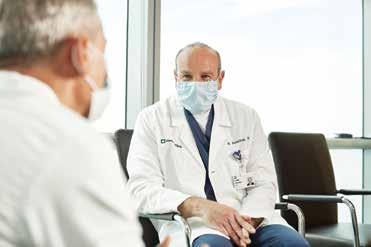

Global Patient Services Serving patients who come from outside their home country to receive care at a Cleveland Clinic facility is also a priority. Through its Global Patient Services, patients are assisted with travel and accommodation arrangements appropriate for their condition, interpretation services, and care coordination, all with a thorough understanding of the cultural background and needs of patients and their families.
Dr. Nizar Zein, Chairman of Global Patient Services for Cleveland Clinic, says: “While patients travel to our facilities looking for the best possible care available, they also need empathy – a team who understands their individual needs, medical or otherwise, and who involve them in their own treatment plans.”
Since its founding in 1921, Cleveland Clinic has significantly changed the healthcare landscape in the U.S., and as it approaches its 100th anniversary, its impact in raising the standards of healthcare globally is increasingly evident.
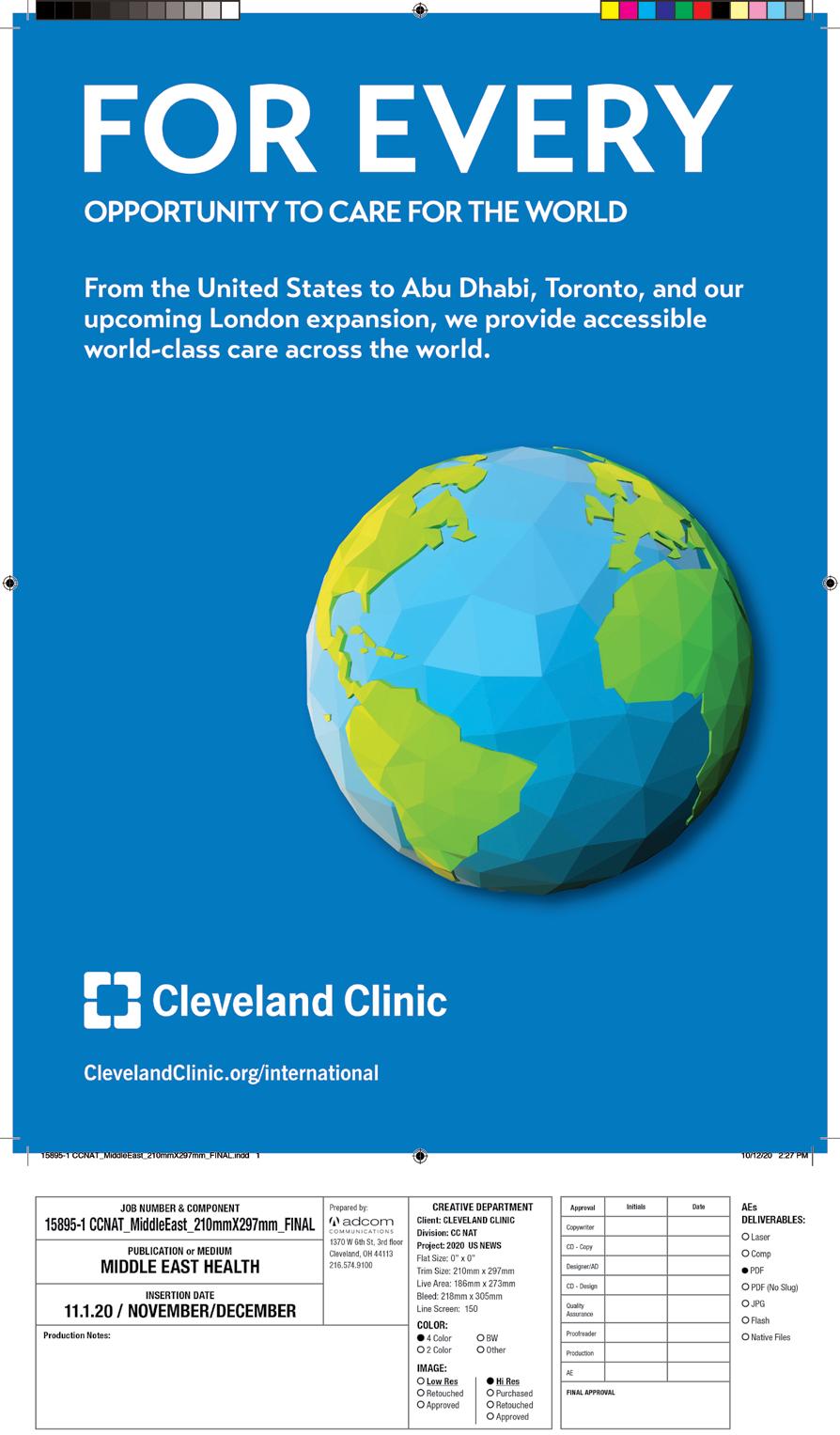
Miami Cancer Institute
Groundbreaking analysis unveils key developments for brain metastases patients
As part of a multi-institutional effort spanning three countries, Miami Cancer Institute has contributed to groundbreaking analysis that reveals overall median survival for patients with brain metastases has improved over time.
Moreover, the analysis identifies that certain subsets of brain metastases have substantially better survival. This has lead to the creation of an algorithm to estimate patient survival, individualize treatment, and stratify clinical trials. Given the survival improvement and current availability of therapies that can effectively treat brain metastases, these patients should no longer be excluded from clinical trials.
Results of this analysis were recently reported in the Journal of Clinical Oncology, <https://doi.org/10.1200/JCO.20.01255> examining a database of 6,984 patients from 18 institutions in the United States, Canada and Japan. Among the key results is that the median survival for brain metastases patients has improved, but varies by subset: lung cancer, 7-47 months; breast cancer, 3-36 months; melanoma, 5-34 months; gastrointestinal cancer, 3-17 months; and renal cancer, 4-35 months. As such, the findings led to the evolution of an algorithm to assess a patient’s survival.
“Our report evaluates the outcomes of patients with brain metastases in the modern era, identifying variables that can predict survival for a given patient,” said Minesh Mehta, M.D., deputy director and chief of radiation oncology at Miami Cancer Institute, as well as senior author of the report. “We’ve found that there are subcategories of patients who have substantially better survival – we’re talking survival in years compared to months. No longer is it appropriate to categorize all patients with brain metastases as having just one outcome.”
Previously, the authors of the report developed and refined a Graded Prognostic Assessment (GPA), a diagnosis-specific index for patients with brain metastases. Those prognostic factors were weighted in proportion to their significance and scaled so that patients with the best or worst prognosis would have a GPA of 4.0 or 0.0, respectively. The new findings gather updated GPAs into a single report to define the eligibility quotient, which would identify patients best suited for clinical trials.
These updated GPAs are now available as a free tool for clinicians to accurately estimate a patient’s survival, individualize treatment and stratify clinical trials and can be accessed at www.brainmetgpa.com.
“No longer does one need to speculate or guess to make a prediction on a brain metastases patient’s survival. Our GPA tool is extremely accurate and helpful in guiding a patient’s decision-making,” said Dr. Mehta. “It allows for a robust and accurate discussion of options between the patient and the clinician in a matter of minutes.”
In the United States alone, an estimated 300,000 patients are diagnosed each year with brain metastases. In the remote past, the average survival for brain metastases patients was poor at only about 3-6 months, and the majority of patients could not effectively be treated with most systemic therapies. It was not uncommon for these patients to be treated in a palliative manner and referred to hospice. With the advent of this new analysis, instead of excluding patients with brain metastases from clinical trials, it is recommended for enrollment to be encouraged and for the
Minesh Mehta, M.D., deputy director and chief of radiation oncology at Miami Cancer Institute.
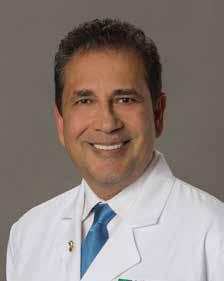
trials to be stratified to ensure appropriate comparisons are made.
“It becomes a self-fulfilling prophecy if we start assuming that brain metastases patients are going to have poor survival and therefore, we don’t enrol them in trials with agents that could be effective for their treatment. Instead, if we recognize that these patients can have better survival and enrol them on these trials, we might in fact identify newer agents that are more effective,” said Dr. Mehta. “What’s important to recognize is that we have to stratify clinical trials because patients with brain metastases have different survival rates. We have to have different categories, which will ultimately balance the arms of clinical trials.” • For information about clinical trials currently underway at Miami Cancer Institute, please visit: https://cancer. baptisthealth.net/miami-cancer-institute/ clinical-trials.

Baylor St. Luke’s Medical Center
How has deep brain stimulation benefitted patients with Parkinson’s disease?
Dr. Sameer Sheth, neurosurgeon at Baylor St. Luke’s Medical Center, uses deep brain stimulation (DBS) as an alternative to medication for treating disorders such as Parkinson’s disease and essential tremor. DBS involves placing a device called a neurostimulator that sends electrical impulses through implanted electrodes to specific targets in the brain.

Dr. Sameer Sheth, neurosurgeon at Baylor St. Luke’s Medical Center
What is deep brain stimulation and how does it work? “DBS is a therapy that we have for various neurological conditions,” said Dr. Sheth. “It’s a system that you can think of like a pacemaker. But rather than being a pacemaker for the heart, it’s for the brain.”
Dr. Sheth describes the brain as having many circuits that govern everything we do, including how we move.
“If the movement circuit is not working properly, we may have a movement disorder like Parkinson’s,” he said. “If we can identify the circuit within the brain that is not working properly, we can use this device to reset the rhythms in the brain and restore the balance so that our movements can be better controlled or without a tremor.”

How effective is DBS therapy? Though DBS is considered an alternative, it’s a well-established, FDA-approved technique that has been used to treat Parkinson’s and essential tremor for 30+ years.
“There’s been a lot of studies over the years,” said Dr. Sheth. “Randomized trials have been presented in the top medical journals that show that for the appropriately chosen patient, DBS is more effective than the best medical therapy. So, in that appropriately chosen patient, DBS can be very successful at improving tremor for essential tremor and tremor stiffness, rigidity, and those other motor symptoms of Parkinson’s disease.”
One patient who has found success with DBS is Rudy Hardy.
“It’s made a profound difference in my life,” said Hardy. A professional sports photographer and professor of criminal justice, Hardy’s life was controlled by Parkinson’s. He tried medication initially, and though it seemed to work for a while, his tremors eventually worsened. Since undergoing DBS, Hardy’s symptoms are now almost completely undetectable.
How does DBS compare to other methods of treatment for Parkinson’s disease? As in Hardy’s case, every patient’s treatment begins with medication until it is determined that they can benefit from DBS. “Medications are always tried first. Unfortunately, we can only get so far with medications. Oftentimes, many patients try them, and they may work for a little while,” said Dr. Sheth.
“But at some point, oftentimes the medications stop working as much because the disorder tends to progress over the years. It could get worse, and the medicines may not be able to keep up. Many of the medicines themselves have their own side effects. So, you get to a point where perhaps the medicines are helping to a degree, but they’re causing their own side effects, and exactly when we get to that point is when we introduce the idea of a surgical therapy like DBS.”
How common Is DBS? Dr. Sheth describes DBS as a very standard Patients need to know that there are these alternatives. They need to know that they’re not necessarily stuck with these symptoms, that there may be a different way to get better control.
treatment. “These are procedures that we do week in and week out,” he said. “It’s not investigational or experimental.” Around the world, more than 150,000 patients have had DBS for Parkinson’s or tremor with a success rate of 95%.
“Patients need to know that there are these alternatives. They need to know that they’re not necessarily stuck with these symptoms, that there may be a different way to get better control. That discussion is, of course, individual-specific, but the availability of these types of surgical treatments is important for patients to know about.”
As Houston’s leader in neurology and neurosurgery, the Neuroscience Institute at Baylor St. Luke’s Medical Center is continually working to find better treatments for neurological conditions to help patients get back their lives. • For more information: StLukesHealth. org/BSLMCInternational international@stlukeshealth.org Tel: +1 832-355-3350 Texas Medical Center, Houston, Texas – U.S.A
